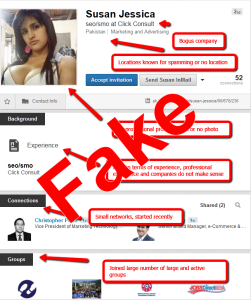 Before we look at the six ways to detect fake LinkedIn profiles, it’s important to understand the driving force behind these profiles and the main reason is spamming.
Before we look at the six ways to detect fake LinkedIn profiles, it’s important to understand the driving force behind these profiles and the main reason is spamming.
Spamming has been around for a long time, first via email and as blogs started proliferating, spammers started polluting blogs, it was only a question of time before they started polluting social media platforms
Coming back to LinkedIn, two of the best way to get maximum exposure on LinkedIn are growing your network or participating in large, active discussion groups. Both imply creating a profile and since spammers learn early on that to effectively spam, they needed many identities, in case they were filtered out.
Over the past few years, we have seen a rapid increase in the number of fake profiles created by spammers either joining discussion groups or asking to join users networks, they usually target large active discussion groups and/or users with large networks, especially LIONs (LinkedIn Open Networkers) who are not too selective in growing their network and allow spammers to develop their network based on first and second degree connections.
Of course, there are a number of ways to stop them, the first one is to be selective in who you accept in your network, the second is for group owners to be more proactive in monitoring who joins their groups and to not fall into the temptation to grow the size of their group at the expense of the quality of the discussion. Continue reading “Six Ways To Detect Fake LinkedIn Profiles”





